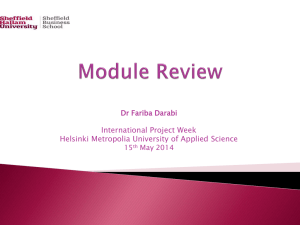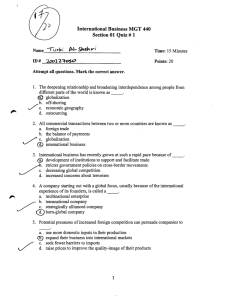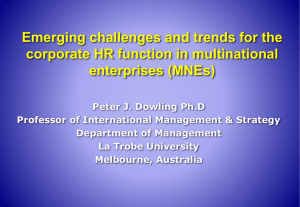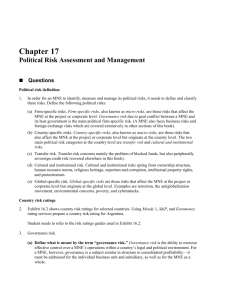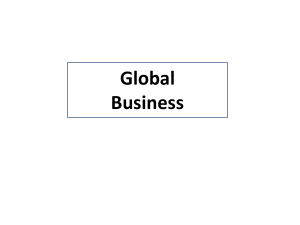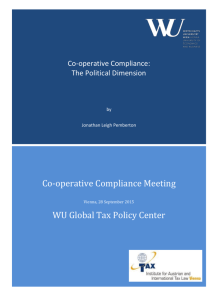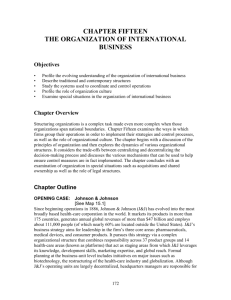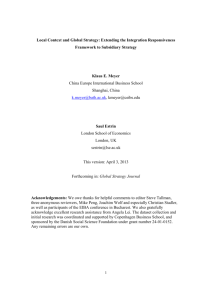Strategy_and_Structure
advertisement
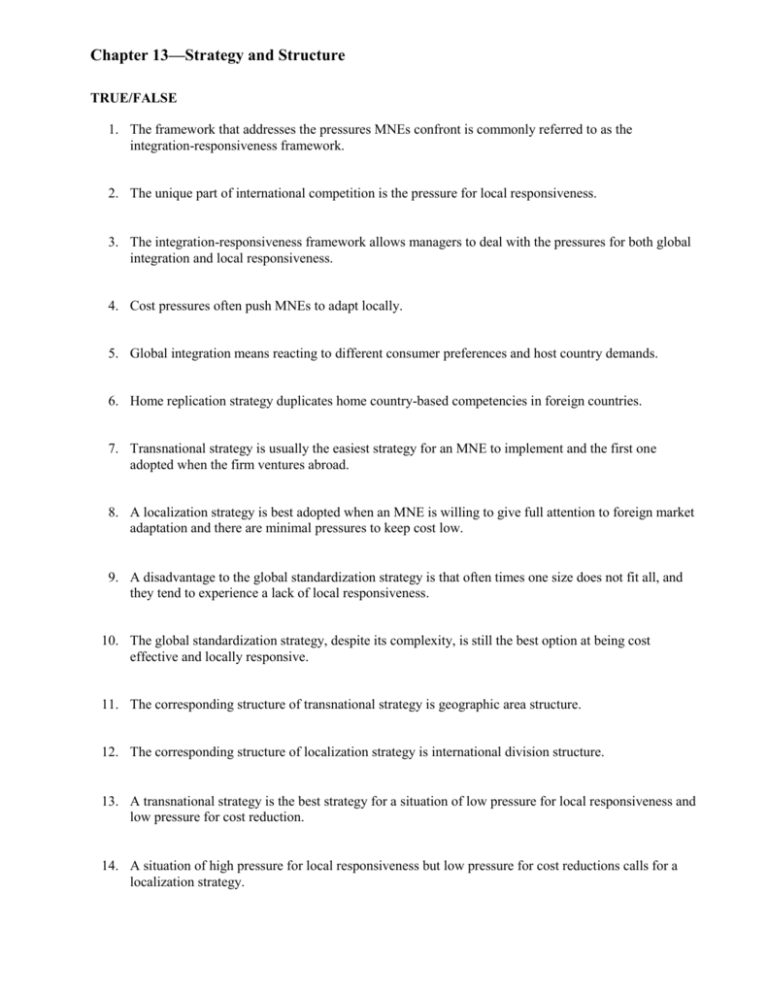
Chapter 13—Strategy and Structure TRUE/FALSE 1. The framework that addresses the pressures MNEs confront is commonly referred to as the integration-responsiveness framework. 2. The unique part of international competition is the pressure for local responsiveness. 3. The integration-responsiveness framework allows managers to deal with the pressures for both global integration and local responsiveness. 4. Cost pressures often push MNEs to adapt locally. 5. Global integration means reacting to different consumer preferences and host country demands. 6. Home replication strategy duplicates home country-based competencies in foreign countries. 7. Transnational strategy is usually the easiest strategy for an MNE to implement and the first one adopted when the firm ventures abroad. 8. A localization strategy is best adopted when an MNE is willing to give full attention to foreign market adaptation and there are minimal pressures to keep cost low. 9. A disadvantage to the global standardization strategy is that often times one size does not fit all, and they tend to experience a lack of local responsiveness. 10. The global standardization strategy, despite its complexity, is still the best option at being cost effective and locally responsive. 11. The corresponding structure of transnational strategy is geographic area structure. 12. The corresponding structure of localization strategy is international division structure. 13. A transnational strategy is the best strategy for a situation of low pressure for local responsiveness and low pressure for cost reduction. 14. A situation of high pressure for local responsiveness but low pressure for cost reductions calls for a localization strategy. 15. Localization strategy is an extension of the home replication strategy. 16. International division structure is an organizational structure typically set up when a firm first engages in a home replication strategy. 17. Global product division structure organizes the MNE according to different geographic areas. 18. One of the disadvantages of the geographic area structure is that country and regional managers are not given sufficient voice relative to the heads of the domestic divisions. 19. A global matrix structure alleviates the disadvantages associated with both geographic area and global product division structures. 20. The global product division seeks to balance local responsiveness with efficiency while the global matrix seeks to provide the world with standardized products, seeking to reach their full market potential. 21. All firms evolve in the same direction from relatively simple international division, through either geographic area or global product division structures, and may finally reach the more complex global matrix stage. 22. Strategy usually drives structure, but structure does not usually drive strategy. 23. Host countries tend to prefer higher end jobs such as advanced manufacturing, R&D, and regional headquarters, while the MNE may prefer to outsource low-end jobs. 24. Generally, US MNEs tend to appoint a relatively equal number of American nationals, third party nationals, and host country nationals as head managers. 25. The top executives at the highest level of an MNE are usually host country nationals. 26. How MNEs are governed internally is determined by formal and informal rules. 27. Explicit knowledge is codifiable and can be transmitted by information technology. Tacit knowledge is noncodifiable and requires hands-on communication. 28. From a resource perspective, tacit knowledge is harder to transfer than explicit knowledge. 29. Regarding knowledge flow in MNEs, firms adopting the transnational strategy experience the highest knowledge interdependence while firms adopting the localization strategy experience the lowest. 30. In home replication strategy, knowledge flow is multidirectional, while in transnational strategy, it is one-way. 31. The idea of open innovation is based on the claim that firms that share information outperform those that fail to do so. 32. Social capital is the ability to recognize the value of new information, assimilate it, and apply it. 33. Subsidiary initiatives refer to subsidiaries reacting to headquarters' demands differently. 34. Allowing subsidiaries greater freedom and responsibility usually encourages entrepreneurship and innovation. 35. The best practice to manage a global matrix is to add additional management positions and spread out the responsibility internally in order to add customer focused dimensions. MULTIPLE CHOICE 1. Which are the two primary pressures MNEs confront? a Ethics and governance . b Cost reductions and local responsiveness . c Liability of foreignness and investment risk . d Local and foreign government . 2. Which is an economic result when an MNE acts locally responsive? a The local government is appeased. . b Regulations are loosened. . c Innovations are limited. . d Costs are increased. . 3. The prediction that people around the world would be drinking Coke, wearing Levi jeans, and watching MTV on their Sony TVs was based on which idea? a Worldwide increase in GDP . b Worldwide increase in money used for luxuries . c . d . Worldwide convergence of consumer tastes Worldwide connectivity with communication technology 4. Which of the following is NOT one of the four strategic choices for MNEs? a Localization . b Global standardization . c Home replication . d Asset allocation . 5. Which is one of the disadvantages of the home replication strategy? a It focuses too much on the home country. . b It is organizationally complex and difficult to implement. . c It focuses too much on the foreign country. . d It has higher costs due to duplication efforts in multiple countries. . 6. Which strategy for MNEs is best for environments where there are clear differences between the home and foreign markets and there is a low pressure for cost reduction? a Home replication strategy . b Localization strategy . c Global standardization . d Asset allocation . 7. Which of the following organization structures is the corresponding structure to localization strategy? a Geographic area structure . b Global matrix structure . c International division structure . d Global product division . 8. Which of the following strategy is the best response to high pressure for local responsiveness and high pressure for cost reductions? a . b . c . d . Global strategy Home replication strategy Localization strategy Transnational strategy 9. A localization strategy is the best response to ____ pressure for local responsiveness and ____ pressure for cost reductions. a High.....high . b Low.....low . c High.....low . d Low.....high . 10. A global standardization strategy is the best response to ____ pressure for local responsiveness and ____ pressure for cost reductions. a High.....high . b Low.....low . c High.....low . d Low.....high . 11. A(an) ____ structure is the best organization structure for MNEs in a situation with low pressure for local responsiveness and high pressure for cost reduction. a Geographic area structure . b Global matrix structure . c International division structure . d Global product division . 12. Which strategy for MNEs entering foreign markets is best described as the development and distribution of standardized products worldwide to reap maximum benefits from low cost advantages? a Asset allocation . b Localization strategy . c Home replication strategy . d . Global standardization 13. A ____ focuses on a number of foreign countries/regions, each of which is regarded as a stand-alone market worthy of significant attention and adaptation. a Global strategy . b Home replication strategy . c Localization strategy . d Transnational strategy . 14. MNEs adopting ____ may designate centers of excellence. a Global strategy . b Home replication strategy . c Localization strategy . d Transnational strategy . 15. A ____ is a subsidiary explicitly recognized as a source of important capabilities, with the intention that these capabilities be leveraged by and/or disseminated to other subsidiaries. a Partner resources division . b Global product division . c Center of excellence . d Small business unit . 16. A global mandate is a charter to be responsible for: a One MNE function throughout the world . b One MNE function in a foreign subsidiary . c All MNE functions throughout the world . d All MNE functions in a foreign subsidiary . 17. Which strategy is most difficult to implement and is the most organizationally complex? a Localization strategy . b Transnational strategy . c . d . Home replication strategy Global standardization 18. Which of the following is a leading problem with the international division organizational structure? a It is not locally responsive. . b It tends to be phased out first when a firm faces domestic challenges. . c It is too locally responsive . d The management team is duplicated, creating organizational confusion. . 19. Which of the following best describes the strength and weakness of the geographic area structure? a Cost of business. . b Cost of equity. . c Level of local responsiveness. . d Management control. . 20. What is the drawback to the global matrix approach? a The complex levels of management often have conflicting incentives, which require va. luable time to align. b While teamwork is realized, it is difficult to know whom to blame or praise when things . go poorly or well. c The management complexity creates slow decision making. . d All of these answers . 21. Which of the following is NOT part of the reciprocal relationship between strategy and structure? a Strategy usually drives structure. . b Structure also usually drives strategy. . c Strategies and structures have to be ready to change all the time. . d All of these answers . 22. Which of the following best exemplifies how informal institutions govern MNEs? a The US has few laws limiting US firms from creating subsidiaries overseas, but there is . often a vocal backlash from the public over domestic job loss. b MNEs coming into the US have relatively few restrictions, as long as they do not prac- . c . d . tice illegal dumping or price setting. MNEs based in the US must advance quickly into foreign markets to beat competitors and take care of opportunities, but these moves are often slowed by legal regulations and entry barriers. The laws governing MNEs based in the US are always changing. 23. Which of the following best describes the motive for appointing a host country national as head manager in a MNE subsidiary? a They are familiar with the intricate workings of the MNE. . b They are independent of the local traditions and MNE so act as a neutral leader. . c They are familiar with the local informal institutions and market. . d Host country nationals are never appointed as head manager. . 24. Which best describes what is meant by the phrase "value of innovation"? a It is important for a firm to add concrete value. . b Structural changes are focused on finding new value. . c Not all innovation is valuable, so finding profitable innovation is crucial. . d How an organization is structured is directly related to how valuable it is. . 25. Which best describes the weakness behind enterprise resource planning packages (ERP) and MNE strategy? a ERPs only help a firm beginning home replication strategy, so they have low levels of . local responsiveness b ERPs help a firm compete as efficiently as possible, but they are designed for widespread . use by many MNEs so they do not help a firm achieve strong rarity. c The cost of ERPs usually does not outweigh its benefits. . d ERPs help with organization and imitability, but are rarely able to help a firm establish . more value. 26. Why is the flexible global matrix a popular organizational structure right now? a Because formal structures are easier to observe and imitate than informal structures, and . it is more of a management mentality than an organizational structure. b Because it balances local responsiveness and cost efficiency. . c Because it allows efficiency and simplicity in management levels. . d Because it takes everything global and efficiently creates standardized products and mar. keting. 27. ____ is the structures, processes, and systems that actively develop, advance, and transfer knowledge. a Absorptive capacity . b Tacit knowledge . c Explicit knowledge . d Knowledge management . 28. If an MNE wishes to maintain innovation-based firm heterogeneity (being different from other firms), which of the following best describes a potentially successful strategy? a Invest much more in a centralized, close-knit R&D . b Spread R&D work across different locations and teams around the world . c Outsource R&D to other firms . d Make alliances with other firms that have strong R&D departments . 29. ____ is the idea that innovation relies more on collaborative research among various internal units, external firms, and university labs. a Collaborative innovation . b Open innovation . c Closed innovation . d Heterogeneity . 30. ____ is the informal interpersonal relationships among managers of different units that may greatly facilitate intersubsidiary cooperation among various units. a Social capital . b Absorptive capacity . c Micro-macro link . d Subsidiary initiative . 31. ____ is the ability to recognize the value of new information, assimilate it, and apply it. a Social capital . b Micro-macro link . c Absorptive capacity . d . Global mandate 32. ____ is the informal benefits individuals and organizations derive from their networks. a Social capital . b Micro-macro link . c Absorptive capacity . d Global mandate . 33. Which best describes the tension between central control and subsidiary initiative in a large firm? a The central management must realize social capital in order to take advantages of the . complex subsidiary relationships. b The central management's main motivation is value for the firm, so it will only give sub. sidiaries greater responsibility if they create value. c The central management may want to give subsidiaries control and encourage entrepre. neurship and innovation, but it is difficult to distinguish between good faith subsidiary initiative and opportunism. d All of these answers . 34. Which is one solution to levy the complexity of the global matrix strategy with added customerfocused dimensions? a Hire a consultant. . b Add more temporary informal bosses . c Bring more revenue to personnel . d Simplify the structure . 35. Which of the following is NOT one of the major management strategies? a Understand and be prepared to change the internal rules of the game governing MNE . management. b Understand and carefully control subsidiaries and minimize autonomous and locally . dependent teams. c Understand and master the external rules of the game governing MNEs and home/host . country environments. d Develop learning and innovation capabilities to leverage multinational presence as an . asset. Open Questions 1. Explain the prediction of worldwide convergence of consumer tastes made by Theodore Levitt, and determine whether or not it was accurate. 2. Identify three strategic choices for MNEs and list their advantages and disadvantages. 3. Describe how two organizational structures align with their strategic counterparts. 4. Explain the reciprocal relationship between multinational strategy and structure. 5. Explain the issues underlying the nationality of the head of management and the directing board of a company. 6. Define and describe the importance of "open innovation." 7. Explain the dilemma central management faces regarding subsidiary initiative. 8. Explain what a center of excellence is.

